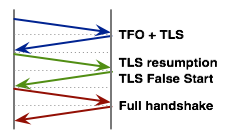What about benchmarks?
Quality of implementation matters — no argument there — and you should do your due diligence. That said, you need to test on your own hardware and with realistic traffic patterns to get an accurate picture of what works best for your specific workload. Don't trust outdated benchmarks, update your OpenSSL libraries, update your server, and run the tests.
TLS operational costs are still higher, right?
Not necessarily. Once you enable and optimize your TLS stack you're also well on your way to deploying HTTP/2. Unlike HTTP/1.1, HTTP/2 requires only a single connection per origin, which means fewer sockets, memory buffers, TLS handshakes, and so on. As a result, it may well be the case that you will be able to handle more users with fewer resources.
TLS still adds an extra RTT; can we fix that?
One possible route is to leverage TCP Fast Open, which would allow us to send the ClientHello within the TCP SYN packet — that would cut another RTT. In the meantime, both TLS 1.3 and QUIC are experimenting with "zero-RTT" handshake mechanisms. See QUIC crypto doc and this GDL episode for a general introduction to QUIC.
Which ciphersuite should I be using?
Mozilla maintains a wiki page with a recommended ciphersuite list and server configuration tips.
If TLS False Start is enabled, do I need resumption?
Both resumption and TLS False Start eliminate an extra roundtrip from the TLS handshake. However, resumption also allows you to skip the asymmetric handshake crypto by reusing parameters from a previous session — this saves CPU cycles. In other words, yes you need both.
I run a multi-server deployment. Any tips?
Ensure you have a shared session cache to get a good cache hit rate on resumed sessions across different servers. Also, ensure you expire and rotate your sessions and session ticket keys in a secure manner, especially when forward secrecy is enabled.
What about certificate costs?
You can get free certificates for any use from Let’s Encrypt. If you need EV verification, then you will have to pay a bit extra. Use your favorite search engine to look for and evaluate the available options. The security and integrity of your visitors' data is worth every penny!
What about Elliptic Curve Cryptography (ECC) certificates?
ECC certificates offer stronger security and smaller certificates - e.g. a 256-bit ECC key is equivalent to a 3072-bit RSA key. ECDSA certificates are recommended for modern TLS clients, such as web browsers, but if you need to support legacy clients (e.g., OS/software from 2008 or earlier often found in enterprise environments) that lack ECDSA support, you can provide RSA as a fallback via a hybrid certificate. Consult the documentation of your server to see if RSA+ECDSA is a supported option.
What about CRIME and BREACH attacks?
CRIME is an attack against compression at the TLS layer. All modern user agents disable TLS compression, but it is still recommended that you disable TLS compression on your server. BREACH, on the other hand, is an attack against compression on top of TLS (e.g. HTTP compression) and must be mitigated both at the server and application levels - read more.
How do I migrate my existing site to HTTPS?
Checkout the HTTPS Everywhere presentation (slides) from Google I/O to learn the best practices and the steps to safely migrate your existing content to HTTPS.
Why do we need HTTPS everywhere?
Every unencrypted HTTP request reveals information about user’s behavior. Today, there is no such thing as insensitive web traffic - read more.
Where can I learn more about TLS performance?

